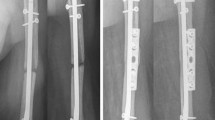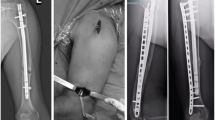Abstract
Purpose
The objective of this study was to evaluate the results achieved after revision with plates of humeral nonunions secondary to failed intramedullary nailing.
Methods
We retrospectively evaluated 32 patients with humeral nonunions secondary to failed intramedullary nailing, treated by internal fixation with plates between 1998 and 2012. Nonunions were diaphyseal in 19 cases, they were located in the proximal humeral metaphysis in nine cases, and in the distal humeral metaphysis in four cases. There were 11 atrophic nonunions and 21 oligotrophic nonunions. Initial treatment was performed with static locked nails in 12 cases, nails with expansive locking systems in 11 cases, and using thin elastic nails in nine cases. The nails were placed antegrade in 18 cases and retrograde in 14 cases. Time between initial surgery and revision surgery averaged 14.5 months. In seven diaphyseal nonunions, the intramedullary nail was left in-situ. Bone graft was added in 25 cases.
Results
Follow-up averaged 35 months. Union was achieved in all cases, after an average of 3.8 months. Disabilities of the Arm, Shoulder and Hand (DASH) score at last follow-up averaged 14 points, and Constant’s score averaged 82 points. The analogue scale of pain averaged 0.8 points. Out of seven patients with radial nerve compromise, six recovered completely and one needed tendon transfers.
Conclusions
Revision with plates after failed intramedullary humeral nailing achieved union and good predictable objective and subjective results in all cases. Adequate implant selection and meticulous surgical technique are necessary to achieve successful osteosynthesis and bony union.



Similar content being viewed by others
References
Anglen JO, Archdeacon MT, Cannada LK, Herscovici D Jr, Ostrum RF (2009) Avoiding complications in the treatment of humeral fractures. Instr Course Lect 58:3–11
Brinker MR, O’Connor DP (2007) Exchange nailing of ununited fractures. J Bone Joint Surg Am 89:177–188
McKee MD, Miranda MA, Riemer BL, Blasier RB, Redmond BJ, Sims SH, Waddell JP, Jupiter JB (1996) Management of humeral nonunion after the failure of locking intramedullary nails. J Orthop Trauma 10:492–499
Rommens PM, Kuechle R, Bord T, Lewens T, Engelmann R, Blum J (2008) Humeral nailing revisited. Injury 39:1319–1328
Dujardin FH, Mazirt N, Tobenas AC, Duparc F, Thomine JM (2000) Failure of locked centro-medullary nailing in pseudarthrosis of the humeral diaphysis. Rev Chir Orthop Reparatrice Appar Mot 86:773–780
Svend-Hansen H, Skettrup M, Rathcke MW (1998) Complications using the Seidel intramedullary humeral nail. Outcome in 31 patients. Acta Orthop Belg 64:291–295
Bain G, Sandow M (1992) Treatment of humeral shaft fractures with the Seidel intramedullary nail. Joint Surg Br 748(1):39
Farragos AF, Schemitsch EH, McKee MD (1999) Complications of intramedullary nailing for fractures of the humeral shaft: a review. J Orthop Trauma 13:258–267
Kurup H, Hossain M, Andrew JG (2011) Dynamic compression plating versus locked intramedullary nailing for humeral shaft fractures in adults. Cochrane Database Syst Rev 15(6):CD005959
Ring D, Jupiter J (2004) Humerus nonunion after intramedullary rod fixation. Locking compression plate without removing the nail. Tech Orthop 18:356–359
Henry AK (1973) Extensile exposure, 2nd edn. Churchill Livingstone, Edinburgh
Allende C, Allende BT (2009) The use of a new locking 90 degree blade plate in the treatment of atrophic proximal humerus nonunions. Int Orthop 33:1649–1654
Alonso-Llames M (1972) Bilaterotricipital approach to the elbow. Its application in the osteosynthesis of supracondylar fractures of the humerus in children. Acta Orthop Scand 43:479–490
Allende C, Allende BT (2009) Post-traumatic distal humerus nonunion: open-reduction and internal fixation: long term results. Int Orthop 33:1289–1294
Gerber A, Marti R, Jupiter J (2003) Surgical management of diaphyseal humerus nonunion after intramedullary nailing: Wave-plate fixation and autologous bone grafting without nail removal. J Should Elb Surg 12:309–313
Ring D, Jupiter JB, Quintero J, Sanders RA, Marti RK (2000) Atrophic ununited diaphyseal fractures of the humerus with a bony defect. Treatment by wave plate osteosynthesis. J Bone Joint Surg 82-B:867–871
Chan YS, Ueng SW, Wang CJ, Lee SS, Chen CY, Shin CH (2000) Antibiotic-impregnated autogenic cancellous bone grafting is an effective and safe method for the management of small infected tibial defects: a comparison study. J Trauma 48:246–255
Allende C (2010) Cement spacers with antibiotics for the treatment of posttraumatic infected nonunion and bone defects of the upper extremity. Tech Hand Upper Extrem Surg 14:241–247
Allende C, Mangupli M, Bagliardelli J, Diaz P, Allende BT (2009) Infected nonunions of long bones of the upper extremity: staged reconstruction using polymethylmethacrylate and bone graft impregnated with antibiotics. Chir Organi Mov 93:137–142
Lammens J, Bauduin G, Driesen R, Moens P, Stuyck J, De Smet L, Fabry G (1998) Treatment of nonunion of the humerus using the Ilizarov external fixator. Clin Orthop Relat Res 353:223–230
Patel VR, Menon DK, Pool RD, Simonis RB (2000) Nonunion of the humerus after failure of surgical treatment. Management using the Ilizarov circular fixator. J Bone Joint Surg 82-B:977–983
Schemitsch EH, Kowalski MJ, Swiontkowski MF (1996) Soft-tissue blood flow following reamed versus undreamed locked intramedullary nailing: a fractured sheep tibia model. Ann Plast Surg 36:70–75
Thomsen NOB, Mikkelsen JB, Svendsen RN, Skovgaard N, Jensen CH, Jorgensen U (1998) Interlocking nailing of humeral shaft fractures. J Orthop Sci 3:199–203
Dalton JE, Salkeldn SL, Satterwhite YE, Cook SD (1993) A biomechanical comparison of intramedullary nailing systems for the humerus. J Orthop Trauma 7:367–374
Schoffer A, Hearn TC, Malisano L, Powell JN, Kellam JF (1994) Comparison of torsional strength of humeral intramedullary nailing: a cadaveric study. J Orthop Trauma 8:414–421
Wu CC (1996) Humeral shaft nonunion treated by a Seidel interlocking nail with a supplementary staple. Clin Orthop 326:203–208
Emmerson KP, Sher JL (1998) A method of treatment of nonunion of humeral shaft fractures following treatment by locked intramedullary nail: a report of three cases. Injury 29:550–552
Nadkarni B, Srivastav S, Mittal V, Agarwal S (2008) Use of locking compression plates for long bone nonunions without removing existing intramedullary nail: review of literature and our experience. J Trauma 65:482–486
Ring D, McKee MD, Perrey BH, Jupiter JB (2001) The use of a blade plate and autogenous cancellous bone graft in the treatment of ununited fractures of the proximal humerus. J Should Elb Surg 10:501–507
Reed AA, Joyner CJ, Brownlow HC, Simpson AH (2002) Human atrophic fracture non-unions are not avascular. J Orthop Res 20:593–599
Garcia P, Pieruschka A, Klein M, Tami A, Histing T, Holstein JH, Scheuer C, Pohlemann T, Menger MD (2012) Temporal and spatial vascularization patterns of unions and nonunions: role of vascular endothelial growth factor and bone morphogenetic proteins. J Bone Joint Surg 94:49–58
Ramoutar DN, Rodrigues J, Quah C, Boulton C, Moran CG (2011) Judet decortication and compression plate fixation of long bone non-union: is bone graft necessary? Injury 42:1430–1434
Connor P, Flatow E (1997) Complications of internal fixation of proximal humerus fractures. Instr Course Lect 46:25–37
King AR, Moran SL, Steinmann SP (2007) Humeral nonunion. Hand Clin 23:449–456
Author information
Authors and Affiliations
Corresponding author
Rights and permissions
About this article
Cite this article
Allende, C., Paz, A., Altube, G. et al. Revision with plates of humeral nonunions secondary to failed intramedullary nailing. International Orthopaedics (SICOT) 38, 899–903 (2014). https://doi.org/10.1007/s00264-013-2180-2
Received:
Accepted:
Published:
Issue Date:
DOI: https://doi.org/10.1007/s00264-013-2180-2




